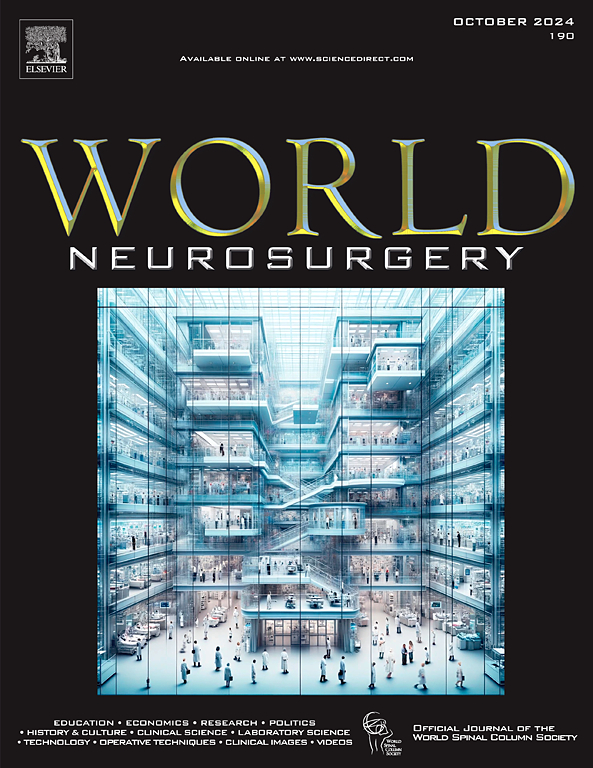Clinical Efficacy of Unilateral Biportal Endoscopic Transforaminal Lumbar Interbody Fusion
IF 2.1
4区 医学
Q3 CLINICAL NEUROLOGY
引用次数: 0
Abstract
Unilateral biportal endoscopic transforaminal lumbar interbody fusion (UBE-TLIF) is an advanced, minimally invasive spinal surgical technique characterized by the use of 2 discrete portals—one for clear visualization and continuous irrigation and the other for the dexterous manipulation of surgical instruments. This configuration not only affords an expanded view (0° or 30°) but also enhances the freedom of movement for instruments, thereby augmenting the precision and flexibility of the surgery. The superiority of UBE-TLIF lies in its capacity to facilitate rapid postoperative recovery with minimal trauma, reduced intraoperative bleeding, abbreviated hospital stays, and significant amelioration of postoperative lower back pain. Comparatively, UBE-TLIF demonstrates equivalent fusion rates and clinical outcomes to traditional open surgeries while also increasing patient satisfaction.1, 2, 3
In the UBE-TLIF procedure, the potential for nerve root disturbance due to surgical manipulation is a critical consideration. To minimize this, the authors have refined the surgical approach, as demonstrated in Video 1. The insertion of a guidewire is prioritized before the fusion process for 2 key reasons: to ensure accurate segmental alignment under the biportal endoscope and to avoid the risk of spinal canal injury that could arise if the guidewire were to be inserted after spinal decompression. The horizontal orientation of the cage is a pivotal technique, as it not only restores spinal curvature effectively but also circumvents the complications associated with oblique insertion, including the prevention of contralateral foraminal narrowing. This strategic positioning is vital for optimizing spinal alignment and reducing the likelihood of iatrogenic issues.4 After cage implantation, the decompression of the dorsal ligamentum flavum is carefully executed, with an emphasis on preserving the ligament to lessen the potential irritation to the nerve roots during the implantation process. This nuanced approach ensures that while achieving spinal fusion, there is also a significant reduction in the risk of nerve root stimulation, striking a harmonious balance between the goals of spinal stabilization and neural element safety.
In this video demonstration, we highlight 2 key advantages of the UBE-TLIF procedure4,5: (1) Optimal lordosis and stability via cage technique: This study introduces a cage-rotation technique that enhances the accuracy and efficacy of UBE-TLIF. The fusion cage is meticulously inserted at a 45° angle to the lamina, with the process halted once two thirds of the cage is in place. An assistant then delicately taps the final one-third segment, ensuring the cage is perfectly aligned with the posterior vertebral edge. This method differs from the traditional oblique insertion, as it significantly improves the spinal lordosis by augmenting disc height, segmental lordosis, and overall lumbar curvature. Additionally, the traverse cage positioning provides enhanced stability, marked by a greater posterior distance from the vertebral body, thus minimizing the potential for cage subsidence or migration. (2) Prioritizing fusion cage insertion for refined decompression6: By prioritizing the fusion cage insertion before the neural decompression, our approach underscores the importance of preserving the ligamentum flavum. This technique reduces neural irritation during the procedure, leading to an improved patient experience postoperatively.
UBE-TLIF offers a safe, efficacious, and swiftly recuperative minimally invasive option for the treatment of lumbar degenerative diseases. It diminishes reliance on costly equipment, thereby facilitating the dissemination and application of this technology in community hospitals.7
单侧双腹腔镜经椎间孔腰椎椎体融合术的临床疗效。
单侧双侧内窥镜经椎间孔腰椎椎体融合术(UBE-TLIF)是一种先进的微创脊柱外科技术,其特点是使用两个不相连的切口,一个用于清晰观察和持续灌注,另一个用于灵巧地操作手术器械。这种配置不仅扩大了视野(0° 或 30°),还提高了器械的移动自由度,从而增强了手术的精确性和灵活性。UBE-TLIF 的优越性在于它能以最小的创伤促进术后快速恢复,减少术中出血,缩短住院时间,明显改善术后下背疼痛。相比之下,UBE-TLIF 的融合率和临床效果与传统的开放手术相当,同时还能提高患者的满意度。1-3 在 UBE-TLIF 手术中,手术操作可能导致的神经根干扰是一个重要的考虑因素。为了尽量减少这种情况,作者改进了手术方法,如视频 1 所示。在融合过程之前优先插入导丝有两个主要原因:确保在双束内窥镜下准确对准节段;避免在脊柱减压后插入导丝可能造成的椎管损伤风险。保持架的水平方向是一项关键技术,因为它不仅能有效恢复脊柱弯曲度,还能避免斜插带来的并发症,包括防止对侧椎管狭窄。这种策略性定位对于优化脊柱排列和减少先天性问题的可能性至关重要。4 在植入脊柱保持架后,背侧黄韧带的减压要谨慎进行,重点是保留韧带,以减少植入过程中对神经根的潜在刺激。这种细致入微的方法确保了在实现脊柱融合的同时,也大大降低了神经根受到刺激的风险,在脊柱稳定和神经元安全这两个目标之间取得了和谐的平衡。在这段视频演示中,我们重点介绍了 UBE-TLIF 手术的两大优势4,5:(1)通过保持架技术实现最佳的前凸和稳定性:本研究介绍了一种可提高 UBE-TLIF 精确性和有效性的骨架旋转技术。将融合骨笼以与骨板成 45° 角的方式小心插入,在三分之二的骨笼就位后停止这一过程。然后由助手小心地敲击最后的三分之一部分,确保骨架与椎体后缘完全对齐。这种方法与传统的斜插法不同,它通过增加椎间盘高度、节段前凸和整体腰椎曲度来显著改善脊柱前凸。此外,横向固定架定位可增强稳定性,其特点是与椎体的后方距离更大,从而最大限度地降低了固定架下沉或移位的可能性。(2) 在进行精细减压之前优先插入融合器笼6:通过在神经减压之前优先插入融合器笼,我们的方法强调了保留黄韧带的重要性。这种技术减少了手术过程中对神经的刺激,从而改善了患者的术后体验。UBE-TLIF 为治疗腰椎退行性疾病提供了一种安全、有效、恢复迅速的微创选择。它减少了对昂贵设备的依赖,从而促进了这一技术在社区医院的推广和应用。
本文章由计算机程序翻译,如有差异,请以英文原文为准。
求助全文
约1分钟内获得全文
求助全文
来源期刊

World neurosurgery
CLINICAL NEUROLOGY-SURGERY
CiteScore
3.90
自引率
15.00%
发文量
1765
审稿时长
47 days
期刊介绍:
World Neurosurgery has an open access mirror journal World Neurosurgery: X, sharing the same aims and scope, editorial team, submission system and rigorous peer review.
The journal''s mission is to:
-To provide a first-class international forum and a 2-way conduit for dialogue that is relevant to neurosurgeons and providers who care for neurosurgery patients. The categories of the exchanged information include clinical and basic science, as well as global information that provide social, political, educational, economic, cultural or societal insights and knowledge that are of significance and relevance to worldwide neurosurgery patient care.
-To act as a primary intellectual catalyst for the stimulation of creativity, the creation of new knowledge, and the enhancement of quality neurosurgical care worldwide.
-To provide a forum for communication that enriches the lives of all neurosurgeons and their colleagues; and, in so doing, enriches the lives of their patients.
Topics to be addressed in World Neurosurgery include: EDUCATION, ECONOMICS, RESEARCH, POLITICS, HISTORY, CULTURE, CLINICAL SCIENCE, LABORATORY SCIENCE, TECHNOLOGY, OPERATIVE TECHNIQUES, CLINICAL IMAGES, VIDEOS
 求助内容:
求助内容: 应助结果提醒方式:
应助结果提醒方式:


